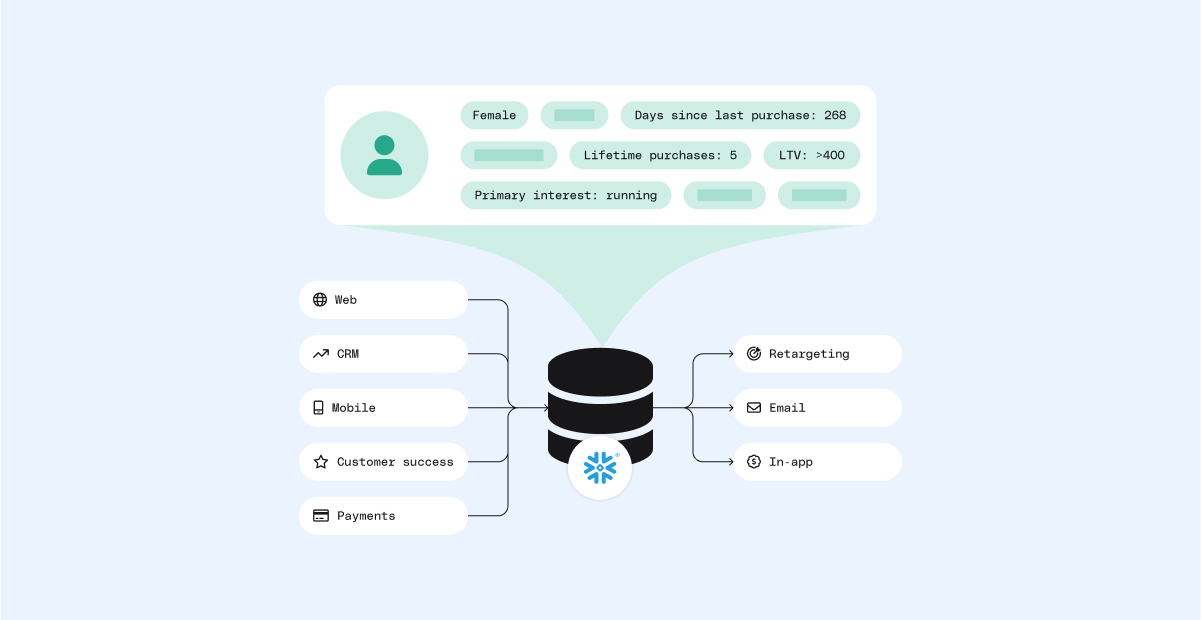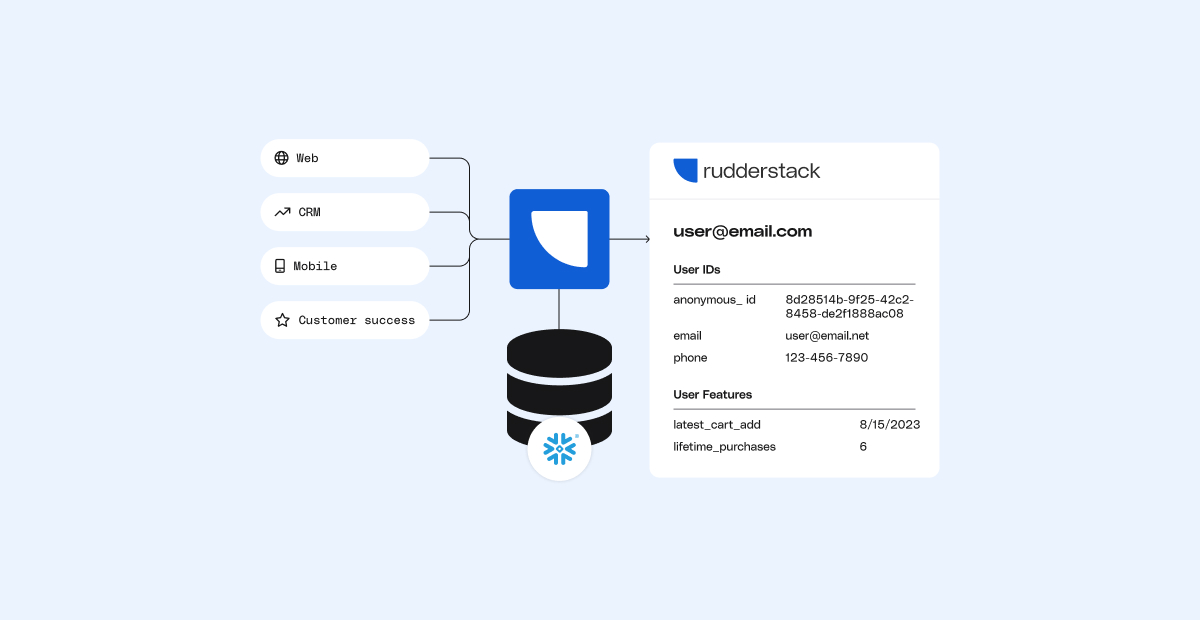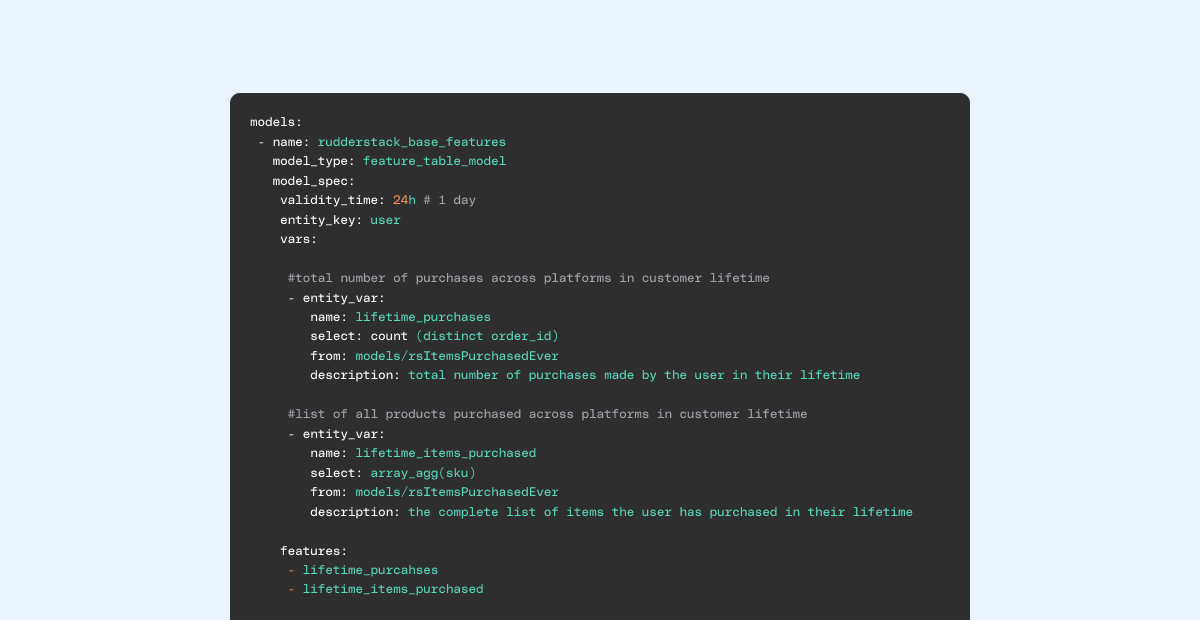Today’s consumer expects a personalized, relevant, end-to-end customer experience. Delivering this level of engagement can drive transformational growth, but it requires a new level of sophistication and a deep understanding of the customer. Data fuels that understanding, and the holy grail for companies is to achieve a holistic view of the customer and their journey.
Historically, gaining that 360-degree view of the customer, known as customer 360, has been out of reach for all but the most advanced businesses. That’s because it requires the investment of considerable time and resources to collect data on every customer touchpoint, then model and unify it into activation-ready profiles. This is an important and challenging technical task for data engineers and data scientists, and it can be costly.
To help customers overcome these challenges, RudderStack and Snowflake recently launched Profiles, a new product that allows every data team to build a customer 360 directly in their Snowflake Data Cloud environment. Gone are the months of complex data wrangling and the constraints of no-code SaaS tools. Now teams can leverage their existing data engineering tools and workflows to build their customer 360. This means reduced costs and accelerated time to value, which delivers a compounding effect on the bottom line and helps data teams position themselves as strategic partners to the rest of the business.
Our shared customers have shipped high-impact customer 360 projects in weeks with RudderStack Profiles. The product is driving 5-10x gains in data engineering productivity and 2x faster machine learning (ML) model development, ultimately allowing marketing teams to deliver 3x more ML-driven campaigns.
Why customer 360?
A 360-degree view of the customer aggregates every data point about every customer—whether online through a website or app, or at a brick-and-mortar store—into a single view where it can be analyzed and used by business teams. That repository typically takes the form of a table in the Data Cloud, with one row per customer and many columns that represent everything you know about that customer. Those columns are often called traits or attributes.
Access to a complete view of the customer is incredibly powerful. It enables organizations to uncover deeper insights about their customer’s journey, and it empowers marketing and product teams to leverage that data to craft engaging customer experiences, delivered at the right time, and personalized to customers’ individual preferences.

Personalized customer experiences produce significant outcomes—McKinsey reports that fast-growing companies drive 40% more revenue from personalization than slow-growing companies. That’s why companies are willing to pay for it. Here are a few notable examples, from our conversations with customers, of the investments executives are willing to make chasing the customer 360:
- $40 million annual budget dedicated to solving identity resolution
- $30 million and 5 years dedicated to building a customer journey map
- 3 years committed to building a complete, usable view of their customer
The magnitude of these investments is representative of the technical challenges behind creating a customer 360.
Customer 360 challenges
The power of a customer 360 is clear, but the term itself lost significance when it became a buzzword. It was incorrectly deemed a marketing problem, and rigid, UI-based tools emerged as a solution, but they failed on their promise. That’s because the customer 360 is, foundationally, a data problem. It requires a modern data platform and data experts to solve it. Today, data leaders are prioritizing the customer 360, and they finally have the tools to equip marketing teams with the data they need.
The Snowflake Data Cloud offering enables access to all of your customer data alongside infinite compute power to model it. This robust environment makes customer 360 projects possible. However, the data engineering and analysis lift required to create actionable customer profiles is still significant.
To achieve a viable customer 360 solution at scale, a data team must:
- Build and maintain an identity graph
- Compute complex user traits
- Represent funnels as part of the journey
- Maintain metadata for predictive traits that change over time
This work is complex and laborious. It’s the type of work that stymies a team’s ability to collaborate with the business on data initiatives that drive revenue.
How RudderStack Profiles makes customer 360 easy in Snowflake’s Data Cloud
RudderStack Profiles functionally eliminates all of this work. It makes it easy to build and ship customer 360 projects natively in the Data Cloud. Once configured, Profiles leverages the power of RudderStack’s end-to-end platform to generate a customer 360 table and activate the complete profiles in over 200 business tools.
Offloading the encumbering work of customer 360 to RudderStack frees you up to focus on those initiatives that can drive business value. Here’s what you can do with RudderStack Profiles:
Accelerate time to value with out-of-the-box identity resolution and user features
When you ingest user data through RudderStack’s Event Stream pipeline into Snowflake, the schemas, unique identifiers, and table relationships are already known. That allows Profiles to automatically generate an identity graph and over 30 event-based user features out of the box.
Data teams can send these data points directly from their warehouse to downstream tools via RudderStack. This frees up data engineers and analysts to uncover new insights, help ship AI models faster, and collaborate with marketing teams on the data they need to create exceptional customer experiences.

Configure identity graphs for any level of complexity
Businesses with multi-faceted identity resolution requirements often face a significant challenge in modeling customer data. For example, an insurance company may want to not only understand their customers at the policy level, but also at the individual customer level (a single insurance policy could cover multiple members of the household). This level of understanding could be important in recommending relevant insurance products, thus increasing customer lifetime value. Modeling these relationships with hundreds of unique identifiers at scale often outstrips the capability of no-code tools.
Profiles drastically simplifies the process of building identity graphs, even at high levels of complexity. In addition to a robust interface, it empowers you to customize identity models through YAML config files that fit within your existing version-controlled development workflows.
With Profile’s clean, comprehensive identity graphs that accurately represent business logic, downstream marketing, product, and customer success teams can ensure they are delivering the right personalized messages, at the right time, with complete context on the customer.

Go beyond identity resolution and deliver data points that drive results
An identity graph is just the first step in building a 360-view of the customer. To complete the picture, you must combine known traits (such as userId and email) with computed traits, such as the number of days a user has been active and the average dollar amount of items in their most recent cart. These computed traits are often the most critical data points for triggering experiences that drive repeat purchases, increase engagement, and improve return on ad spend.
Instead of spending weeks writing complex SQL or updating models in multiple places, data teams using Profiles can write simple feature definitions, and RudderStack will automatically compute the values natively in their Data Cloud environment.
Data teams using Profiles to compute complex traits have improved time-to-value from weeks to days, and have enabled faster cycles on AI model development, analytics projects, and data-driven marketing campaigns.

Take action on the full customer journey with funnels and semantic events
Customer journeys happen over time, and they’re defined both by what users do as well as what they don’t do. This context is critical for business teams who want to improve conversion rates and mitigate churn, but building semantic and funnel-based data sets in SQL is notoriously difficult.
Profiles makes it easy for data teams to model both funnels and semantic events, then send that data directly to business tools. That enables marketing and product teams to take immediate action on the most critical steps of the customer journey.
Accelerate AI projects with historical snapshots and metadata
Operationalizing AI is quickly becoming a competitive requirement for businesses. A common use case like churn prediction requires answering the deceptively simple question “Why did my customer churn?” In order to answer the question, you need to understand both when the customer churned, what their profile looked like when they churned, and the behaviors that led up to the moment of churn. Additionally, training AI models requires a large amount of data: limiting your training data set to the most recent customer profile runs the risk of generating low-confidence results or significantly extending the project timeline.
RudderStack Profiles solves these challenges by automatically capturing changes in your customer 360 over time. Whenever you update your customer 360 with new data, Profiles creates a snapshot table in the Data Cloud, giving your analytics and AI teams full visibility into time series changes in your customer data, enabling significantly faster model development and testing.
How Wyze is moving its business forward with Profiles
Wyze, a Seattle-based smart home technology company, transformed its business with RudderStack Profiles in the Snowflake Data cloud as a beta customer of the new product.
The typical Wyze customer takes a complex journey that can span more than five different platforms. They educate themselves on the marketing website, make purchases through the ecommerce platform, manage devices through mobile apps and subscribe to Wyze’s ongoing monitoring services.
Before Profiles, wrangling data from each of these platforms, with different schemas and unique identifiers, was prohibitively time-consuming for the Wyze data team. It limited their ability to deliver high-quality insights to the business teams trying to create personalized, real-time experiences at key points along the customer journey.
When Wyze activated RudderStack, they first implemented RudderStack’s Event Stream to standardize schemas and user identification across all their data sources—a huge productivity win for the data engineering team. Then, using Profiles, they were able to quickly build out an identity graph and key user features in Snowflake, giving them full visibility into the customer journey across all of their platforms and significantly speeding up the process of developing critical computed traits like days_active and avg_dollar_amount_in_cart.
Wyze realized the results in a matter of weeks. Their marketing team is now shipping three times as many campaigns using ML-scored features, driving incremental revenue. Additionally, their data engineering team is 5-10x more productive because they’re able to focus on value-added work instead of data wrangling and cleaning.
Previously, they’d had a difficult time tying together the full customer journey. For example, a user would browse products on the company website and the Shopify store, then download the mobile app. “To piece all of this together, we would have to go into all of these different systems,” explains Wei Zhou, Director of Data Engineering at Wyze. “With Profiles, we are now able to resolve customer identities using our first-party data, compute machine learning user features, and deliver personalized recommendations to drive revenue.”
Unlock value from your customer data
Building a customer 360 is a challenging exercise, but it’s the key that helps organizations unlock every bit of value from customer data. With customer expectations rising every day, customer 360 is no longer a nice-to-have, it’s a requirement for growth. And Snowflake and RudderStack are making it possible to bring customer 360 to data teams everywhere.
With the introduction of RudderStack Profiles, you can now leverage the full power of RudderStack’s end-to-end platform and Snowflake’s well-governed Data Cloud environment to deliver delightful customer experiences without breaking the bank. Click here to request a demo of Profiles.
